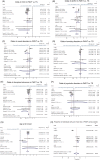Is Persistent Motor or Vocal Tic Disorder a Milder Form of Tourette Syndrome?
- PMID: 33942911
- PMCID: PMC8453968
- DOI: 10.1002/mds.28593
Is Persistent Motor or Vocal Tic Disorder a Milder Form of Tourette Syndrome?
Abstract
Background: Persistent motor or vocal tic disorder (PMVT) has been hypothesized to be a forme fruste of Tourette syndrome (TS). Although the primary diagnostic criterion for PMVT (presence of motor or vocal tics, but not both) is clear, less is known about its clinical presentation.
Objective: The goals of this study were to compare the prevalence and number of comorbid psychiatric disorders, tic severity, age at tic onset, and family history for TS and PMVT.
Methods: We analyzed data from two independent cohorts using generalized linear equations and confirmed our findings using meta-analyses, incorporating data from previously published literature.
Results: Rates of obsessive-compulsive disorder (OCD) and attention deficit hyperactivity disorder (ADHD) were lower in PMVT than in TS in all analyses. Other psychiatric comorbidities occurred with similar frequencies in PMVT and TS in both cohorts, although meta-analyses suggested lower rates of most psychiatric disorders in PMVT compared with TS. ADHD and OCD increased the odds of comorbid mood, anxiety, substance use, and disruptive behaviors, and accounted for observed differences between PMVT and TS. Age of tic onset was approximately 2 years later, and tic severity was lower in PMVT than in TS. First-degree relatives had elevated rates of TS, PMVT, OCD, and ADHD compared with population prevalences, with rates of TS equal to or greater than PMVT rates.
Conclusions: Our findings support the hypothesis that PMVT and TS occur along a clinical spectrum in which TS is a more severe and PMVT a less severe manifestation of a continuous neurodevelopmental tic spectrum disorder. © 2021 The Authors. Movement Disorders published by Wiley Periodicals LLC on behalf of International Parkinson and Movement Disorder Society.
Keywords: Tourette; chronic tics; meta-analysis; severity.
© 2021 The Authors. Movement Disorders published by Wiley Periodicals LLC on behalf of International Parkinson and Movement Disorder Society.
Figures



References
-
- American Psychiatric Association., American Psychiatric Association. DSM‐5 Task Force . Diagnostic and statistical manual of mental disorders: DSM‐5. 5th ed. Arlington, VA, Washington, D.C.: American Psychiatric Association; 2013.
Publication types
MeSH terms
Grants and funding
LinkOut - more resources
Full Text Sources
Other Literature Sources
Medical

